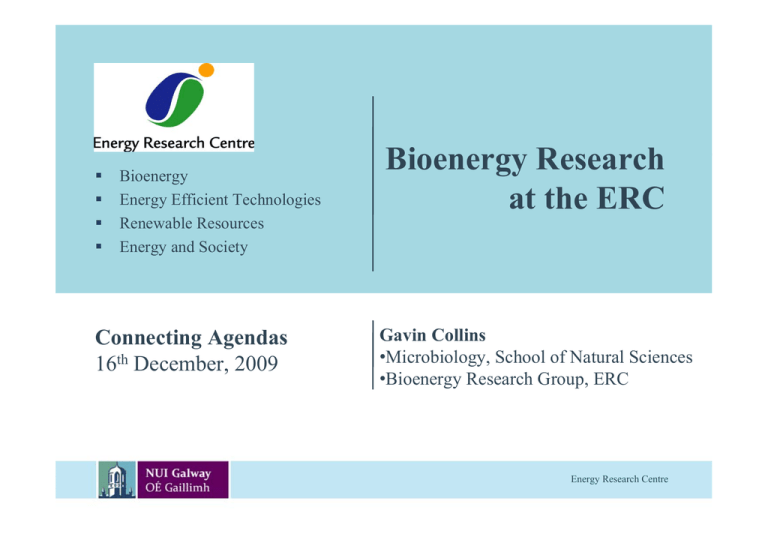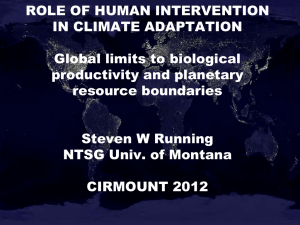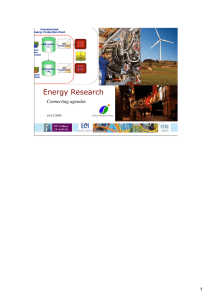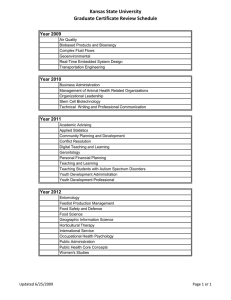Bioenergy Research at the ERC Connecting Agendas 16
advertisement

Bioenergy Energy Efficient Technologies Renewable Resources Energy and Society Connecting Agendas 16th December, 2009 Bioenergy Research at the ERC Gavin Collins •Microbiology, School of Natural Sciences •Bioenergy Research Group, ERC Energy Research Centre Bioenergy • Bioenergy is produced from plant and animal material. – Wood, other plant material, manure from livestock • Biomass can generate: – electricity, light, heat, motion and fuel. • Fuels, such as ethanol, can be made from biomass and used as an alternative to petrol to power vehicles. Energy Research Centre Bioenergy Research at the ERC • Well-established and highly successful area • Key ongoing research: – microbial fermentations and digestion of organic feedstocks – biocatalytic fuel cells – combustion chemistry Energy Research Centre As a microbiologist…. • MICROBES: – can, and will, do anything! – an important natural resource • Microbial Resource Management! – getting the bugs to cooperate – innovative applications – protecting the resource! Energy Research Centre Bioenergy Research at the ERC A Multi-disciplinary cluster – Feedstock characterisation (Algae, biomass, waste resources) – Primary conversion (enzymatic) of feedstock – Fermentation, Biogas and BioH2 – Bioprocess solids and waters treatment and recycling – Waste and wastewater treatment and recycling (Carbon, nutrient, microorganisms, metals, priority pollutants) – Combustion chemistry Energy Research Centre Other & New Research • Anaerobic digestion of municipal sewage • Closing nutrient loops • Sustainable water infrastructures Energy Research Centre Bioenergy Research at the ERC Brief details Energy Research Centre Fuel Cell Science & Technology • Hydrogen supplied to anode of the cell. • Catalyst (usually platinum) breaks apart hydrogen into protons and electrons. • Electrons then transferred (producing current) to cathode • Electrons rejoin with protons & oxygen at cathode to form water. Energy Research Centre Biofuel Cells “Fuel cell utilising biological compounds to catalyse the necessary oxidation and reduction reactions to produce electricity” Biofuel Cell Types Microbial Fuel Cells, which use micro-organisms as catalysts Enzymatic Fuel Cells, which use enzymes derived from organisms as catalysts. Glucose/O2 Enzymatic Biofuel Cell Energy Research Centre Microbial Fuel Cells Energy Research Centre Enzyme technology •Enzymes for pre-treatment •Harness potential of different plant species (e.g. algae) by improving conversion Energy Research Centre Low-temperature Anaerobic Digestion High-rate treatment under sub-ambient conditions (4-15oC) • Eliminate high energy requirement • Improved economics Energy Research Centre Sustainable Bioenergy: a green biorefinery model Energy Research Centre from www.biorefinery.ie Energy Research Centre Combustion Chemistry Rapid Compression Machine Low-pressure shock tube High-pressure shock tube Chemical details of how fuels burn – ICE, gas turbine, incinerator – Fossil or renewable – Efficiency/Health impact Energy Research Centre Combustion Chemistry • Problems with Bioethanol • Biobutanol/Biomethane • Major industrial support Energy Research Centre Future? • Which crops/feedstocks/wastes; – and where, when, how, who? – sustainable? • Technology development & deployment • Fuel acceptability and usage • Life cycle analysis of biorefining systems – of all associated activities and applications Energy Research Centre





